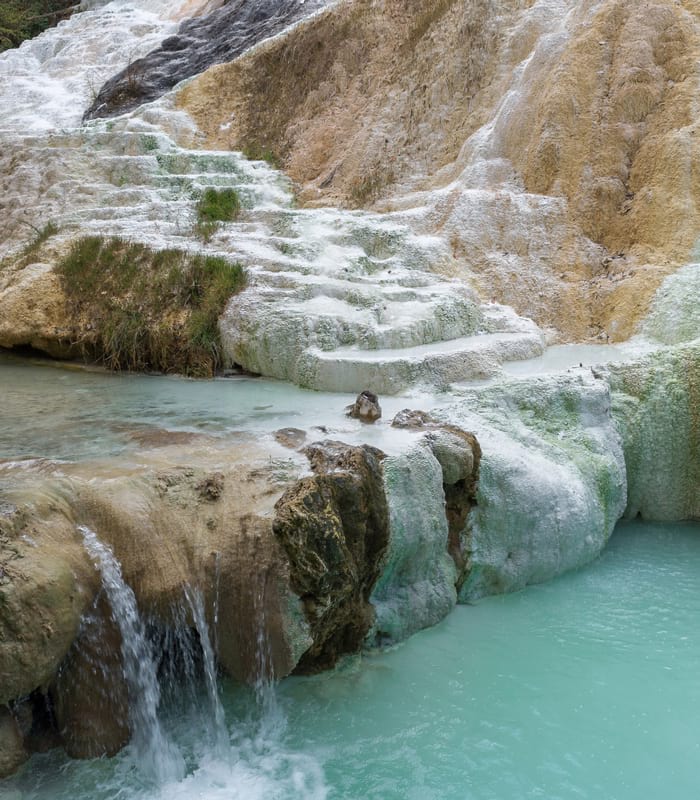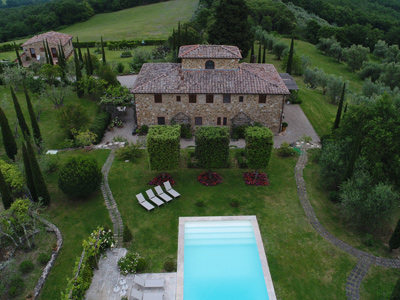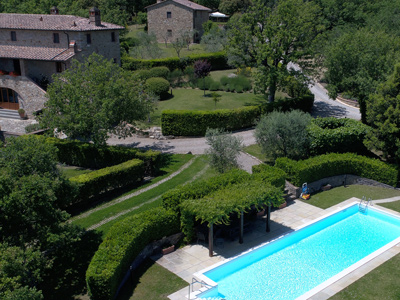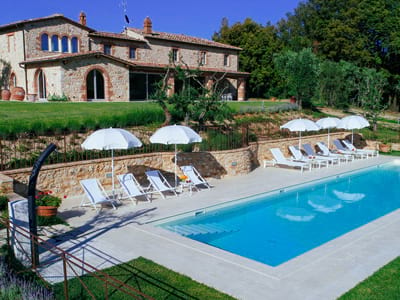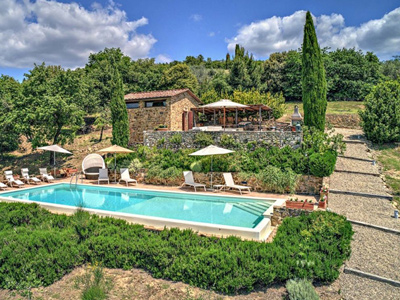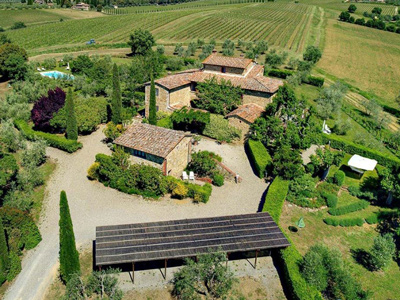TUSCANY DESTINATIONS
Crete Senesi
When you think of Tuscany, do you imagine a postcard picture-perfect scene with a winding track leading up to a Tuscan villa along a cypress lined avenue? But what if you found a bare landscape more like that of the surface of the moon, with strange geological formations right in the middle of Tuscany?
We are talking about ‘Le Crete Senesi’, an area close to Siena that stretches over the communes of Asciano, Buonconvento, Monteroni d'Arbia, Rapolano and San Giovanni d'Asso. Its ‘moonscape’ like landscape having been farmed since Etruscan times.
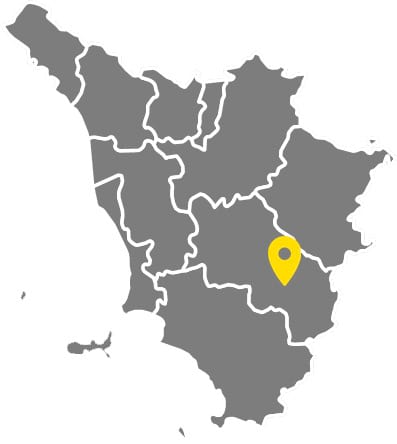
So why is it called ‘Le Crete Senesi’ then?
Well, the area geologically is made up of ancient seabeds and alluvial soils of clay, ‘creta’, sandstone and other softer sedimentary soils and rock. There are ‘biancane’ which are the strange formations formed by soil erosion from heavy rains. These soils are fertile, and the rolling hillsides have been farmed for millenia with the furrows of the ploughing outlining the hillsides and exposing the colours of the soils. These vary from brown and yellows where there are more sandy soils to grey, blue and white of the clays. Rain can really bring out the startlingly bright hues. Such was the intensity of the colours of these soils, the artists of the region ground them into fine powder and mixed with oil to produce pigment paint. Today, artists the world over are familiar with those hues called ‘Siena yellow’, ‘burnt Siena’ and ‘burnt Umbria’ referring to where these colours originated.
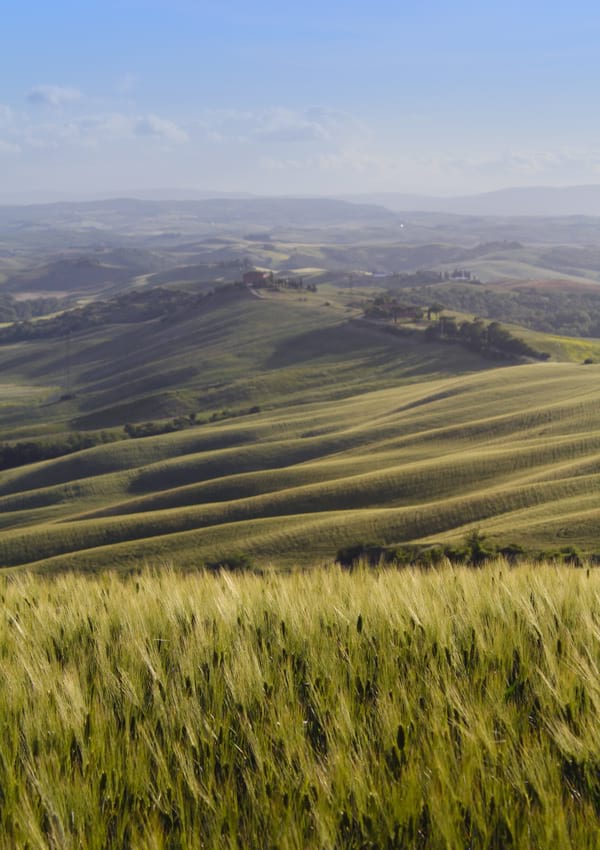
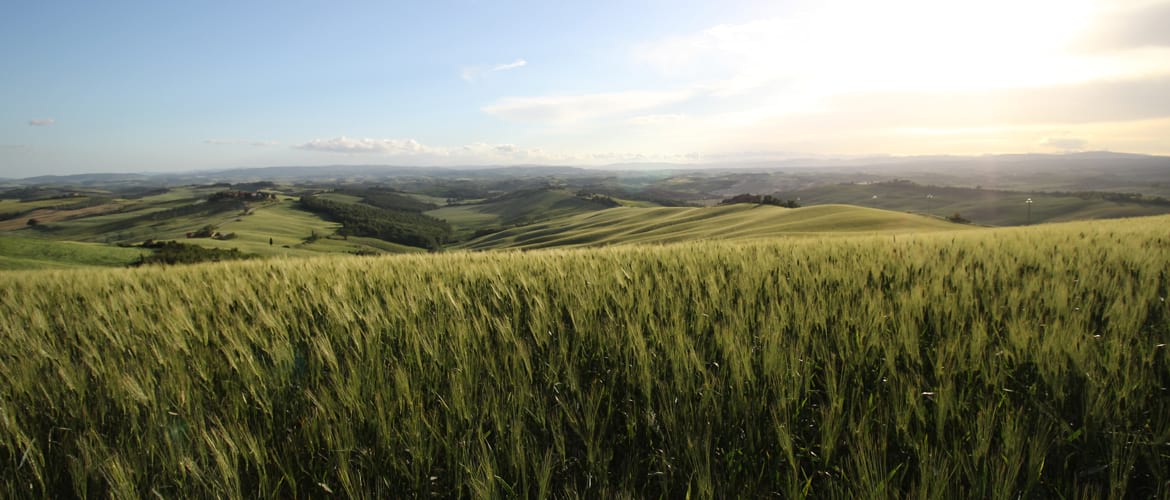
After ploughing ‘Le Crete Senesi’ enjoy a burst of green as the crops grow and cover over the hills which become soft and almost velvet like in appearance. This is also when sunflowers have been planted, we get sight of those famous yellow fields until harvest in June, when the soils are exposed again and the heat of the sun bares the earth and the ‘moonscape’ reappears. At times, depending on the time of day and the light, the ‘Le Crete Senesi’ can appear more like the surface of Mars, red!
Unlike many areas of Tuscany ‘Le Crete Senesi’ is farmland. It is remote in a way, with wide‐open fields and hilltop farmhouses and some villas dotted here and there. There are not much in the way of olive groves or vineyards. So, even though different from much of the rest of Tuscany it is just a stunning landscape to visit southeast of Siena, beloved of artists and photographers. UNESCO has proclaimed this most spectacular and unusual landscape a ‘World Heritage Site’ because of its links to the Renaissance idealisation of ‘man working within nature’ and the ideal of ‘good governance’ according to the thinking of the time. Depictions of these ideals and the opposite are to be found in the frescoes in the ‘Palazzo del Popolo’ in Siena, painted by ‘Ambrogio Lorenzetti’.
There are many sights to see and things to do in this area. At Tuscany Destinations, we can help you find all the hidden gems of ‘Le Crete Senesi’.
What to See and Do Around the Crete Senesi
Asides from the extraordinary landscape, there are a lot of arts and crafts, culture, museums, churches, quaint towns, and many other things to see in the area of ‘Le Crete Senesi’.
Art in the Middle of Nature
A top one of the rounded hills of ‘Le Crete Senesi’ is a strange obelisk like sculpture called ‘Site Transitoire’ reminiscent of the stone monuments of northern Europe, like ‘Stonehenge’, by the French Sculptor Jean-Paul Phillipe (b.1944). It evokes a strange sense of timelessness in its setting within the landscape of ‘Le Crete Senesi’. This masterpiece can be found about two kilometeres from Leonina and has to be reached on foot, the artist has his studio in the town of ‘Asciano’ which finds itself in almost the centre of ‘Le Crete Senesi’. The studio can be visited but it is best to enquire first.
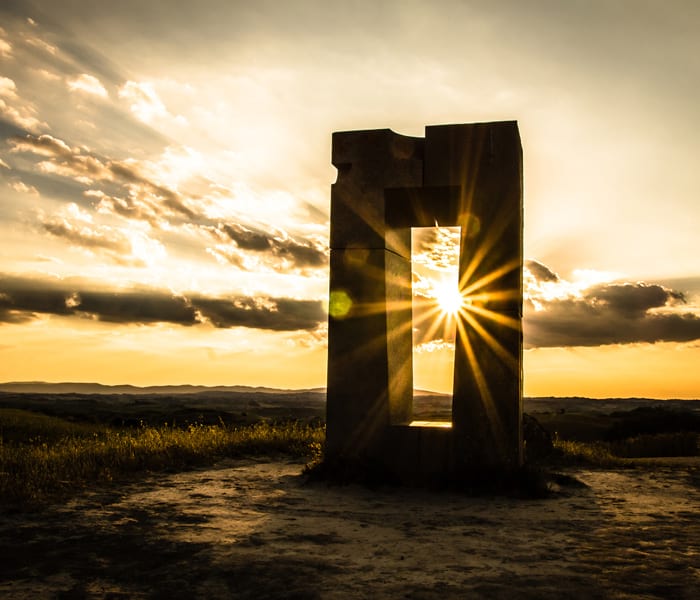
Museums
There are several museums to explore in the area, each with an interest in some particular part of the history and events of the region. The Civic Museum of Archeology and Sacred Art in ‘Palazzo Corboli’ in Asciano. Once owned by the noble Sienese ‘Bandinelli’ family, the ‘Palazzo Corboli’ is not so much a museum but a work of art itself. The arms of the ‘Bandinelli’ appear in almost every room, although small this museum houses allegorical, sacred and secular works from the surrounding area and by numerous artists from the ‘renaissance’ including works attributed to ‘Ambrogio Lorenzetti, Cristoforo di Benoccio, Meo di Pero and Bernardino Mei’ amongst others. Two floors are dedicated to archaeological artefacts from ancient tombs and neocropoli, Etruscan, Roman pieces and finds from a thermal bath.
At the ‘Museo della Grancia’ in Rapolano Terme, you can learn the fascinating history of the fortified storehouses which kept the harvestsafe from attack and supplied the needy of Siena through the ‘Spedale di Santa Maria Della Scala’.
In Buonconvento, there is the ‘Museo della Mezzadria’ a museum dedicated to the social and economic world of sharecropping that no longer exists but was so typical in Tuscany up until the mid-20th century.
You can learn the history of sharecropping in the ‘Crete Senesi’ by way of photos, music, literature, video, historical documents, and much more.
In tribute to one of the worlds most venerated funghi, pay a visit to the Truffle Museum in ‘San Giovanni d’Asso’. Here you can explore the mystery of the truffle in the cellars of the medieval San Giovanni Castle, immerse yourself in the history of the truffle from the scientific as well as the magical side. With a very ‘hands on’ approach you can feel, hear, see, smell and taste the history of the truffle! ‘Le Crete Senesi’ are famous for the white truffle and there is a ‘White Truffle Association’ which every year organises a festival and market of the white truffle in San Giovanni d’Asso. Here you can really enjoy the truffle in some of many delicious dishes based around this pungent funghi!
On the Southern Edge of Le Crete Senesi is the neighbouring district of ‘Val d’Orcia’ where there are to be found the famous picturesque hilltop towns and villagesso characteristic of Tuscany, ‘Pienza’ and ‘San Quirico d’Orcia’ to name two.
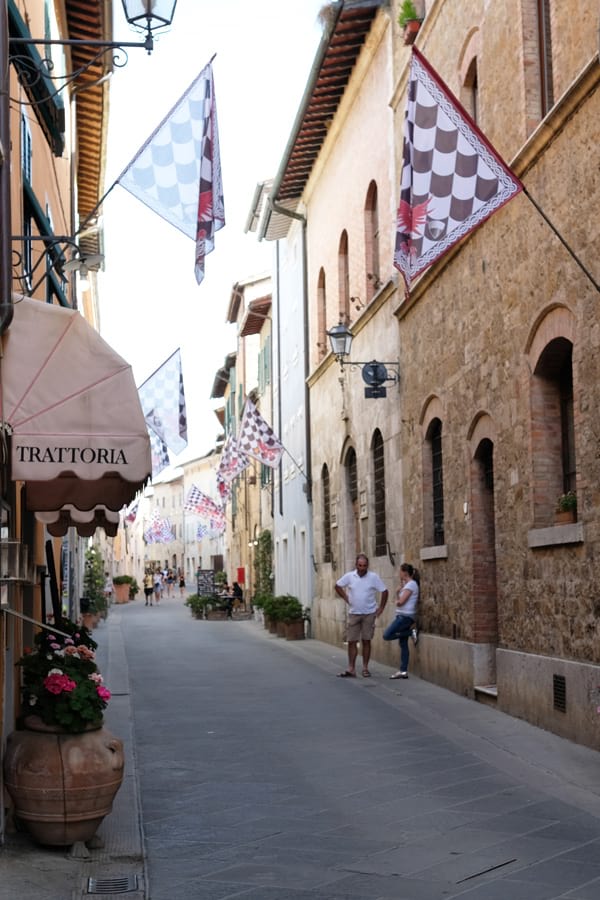
San Quirico d’Orcia
‘San Quirico d’Orcia’ is a hamlet of Etruscan origin perched on a hilltop. This village was an important stop-over along the ‘Via Francigena’ for the pilgrims on the road to Rome. Around San Quirico are found those iconic cypress avenues that are photographed by every tourist passing through Tuscany. In San Quirico, you can admire historical buildings such as ‘Palazzo Chigi’ that today is the Town Hall but has some important frescoes and the ‘Codex Chigi’, a folio of music that one belonged to the Chigi family. There are the churches of ‘San Francesco’ and ‘Santa Maria Assunta’ church. The facade of the latter very much resembles that of the ‘Sant’Antimo’ Abbey in Montalcino – the idea being that familiarity of the buildings showed the pilgrims would know they were on the right route to Rome!
Aside from churches, there are the ‘Horti Leonini’ gardens to enjoy while in San Quirico. The gardens are an excellent example that were designed by Diomede Leoni in 1540. The gardens were used principally by wealthy travellers to relax in and may have had many notable patrons including Cosimo III passing through them. From the walls surrounding these gardens, there is a splendid view of the ‘Val d’Orcia’.
Pienza
‘Pienza’ isthe Utopian City, or the ‘Renaissance ideal town’ that, according to the Italian author Giovanni Pascoli, was “born out of a thought of love and a dream of beauty”. It is also known as the town of Pope Pio II who wanted to turn Pienza into an architectural gem and entrusted the architect Bernardo Rossellino, under the guidance of Leon Battista Alberti over four years in the mid-15th Century, to restructure the small town of Pienza.
Pienza has remained pretty much intact since then. The structures ordered to be built by Pope Pio II are the Cathedral, the ‘Palazzo Piccolomini’, the ‘Palazzo Publicco’ and the main square which is named after Pope Pio II , the town is quite unique. So much so, Pienza is also recognised by ‘UNESCO’ as a ‘World Heritage Site’.
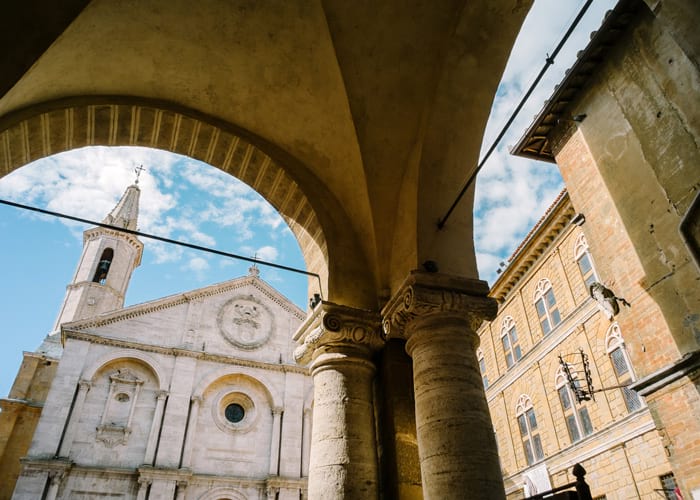
Pienza is also well known world-wide for its cheese, especially the ‘Pecorino di Pienza’. You cannot visit Pienza without getting a taste of this renowned sheep milk product. Aged for varying periods to produce a range of different ‘Pecorinos’ from ‘fresh’ and soft to strong mature ‘hard’ cheese, Pienza is known as the town of ‘Cacio’. (‘Cacio’ from the Latin ‘Caseus’ – ‘cheese’ ‘to ferment’.) Visit Pienza in September and you can experience the ‘Fiera del Cacio’ - Festival of Cheese, and the fun ‘Palio del Cacio Fuso’, basically a form of bowling with the cheeses to win a prize – ‘Palio’, between the six ‘contrade’ (parishes) of the town.
Walking through the quaint little streets of Pienza you can find many small shops selling not only ‘Pecorino’ cheese but also ‘Pici’, a thick type of ‘Spaghetti’ made only from flour and water - a typical local handmade pasta, wines and many other locally produced products.
Asciano – the main district in the area of the Crete Senesi
The main commune or ‘market town’ in the area of ‘Le Crete Senesi’ is Asciano. A town with a picturesque centre, surrounded by medieval walls, like so many other villages and towns in Tuscany. The church ‘Collegiata Sant’Agata’, located at the highest point of the town, is noted for its frescoes from the 16th Century.
In September every year,there isfun to be had watching the ‘Palio dei Ciuchi’ where the town’s‘contrade’ - quarters or parishes -, have an equine race against each other, a sort of ‘mini-palio’ in the ‘Sienese’ style, with donkeys instead of horses!
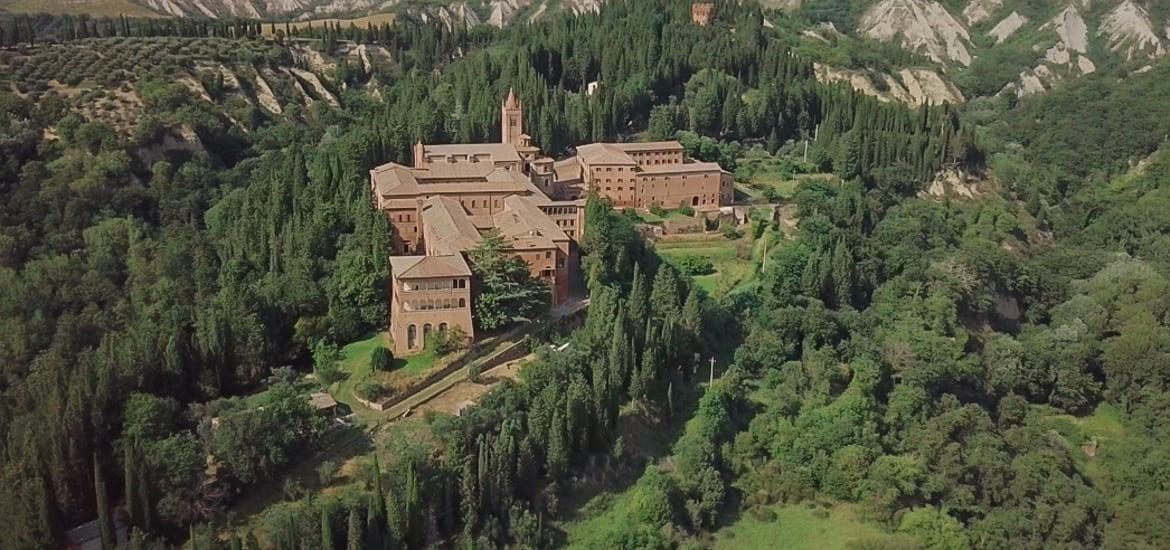
Outdoors activities in the area of the Crete Senesi
There are many outdoor activities you can enjoy around the ‘Crete Senesi’ as hiking, cycling and mountain biking. Go on a beautiful hiking tour through the stunning landscape from the edge of the ‘Crete Senesi’ to ‘Val d’Orcia’ among nature, castles, villas, and farmhouses. Want a more challenging route? Why not try the steeper ‘Strada Bianca’ the white gravel road uphill around Mount Oliveto Maggiore? Even if it is a bit of hard work, it has a breath-taking view and is well worth it!
Prefer biking rather than walking? You can go cycling around the churches, castles and the small hamlets of ‘Le Crete Senesi’. For those who want more action, there are mountain biking tours among the hills around Leonina, Rapolano, or along the Ombrone river.
After such strenuous activity or if you are not an ‘Adrenalin Junkie’ there are more relaxing outdoor activities to enjoy. Tuscany is renowned for its thermal springs some of which may have been in use since before Roman times as naturally heated bathtubs. Some like those in ‘Bagno Vignoni’ are found in the centre of town, used by the Romans and weary pilgrims, the baths are no longer in use, however modern baths and spa ‘Centro Benessere Le Terme’ is to be found nearby. This is not the only place to go, the ‘Adler Thermae Spa and Relax Resort’ is a luxury resort for those with the taste to be really pampered. Should you be more adventurous, the natural thermal springs at ‘Bagni di San Filippo’ have amazing calcium salt formations as water heavily saturated with salts flows over the rocks depositing calcium and turning the rocks white. Free and open to the public, rocks are placed in formation to form calcite pools which fill with hot water and ‘volcanic mud’ layering the bottom, believed to be excellent for the skin. So, one may have a mud mask too while lazing in the pools!
At Tuscany Destinations we are at your disposal to help you plan your dream vacation in ‘Le Crete Senesi’.
